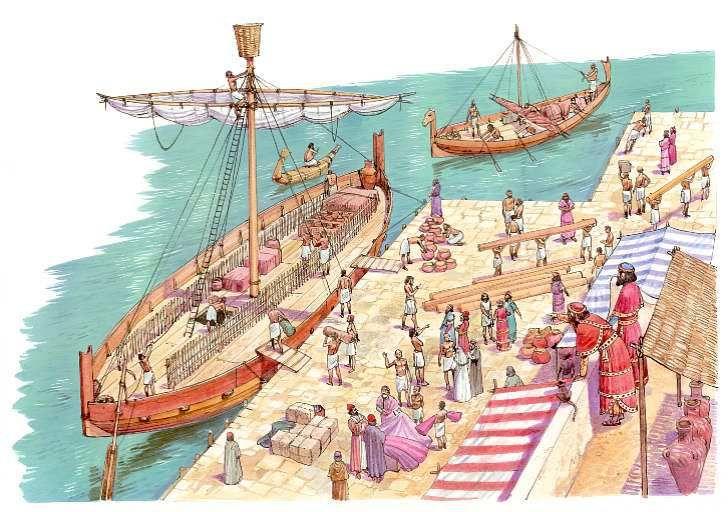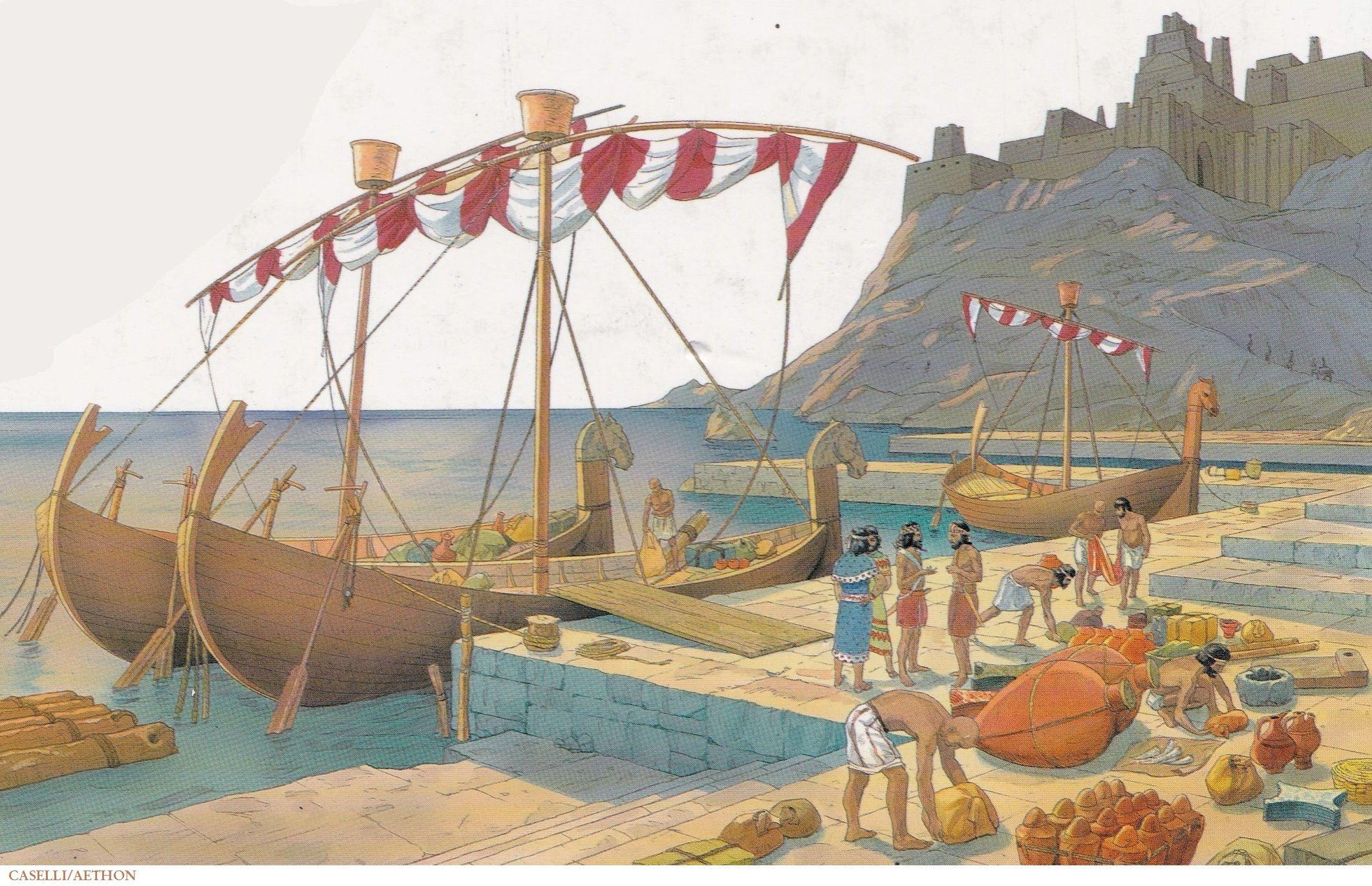Home › Forums › Air and Sea › Naval › Ancient Ships
- This topic has 30 replies, 10 voices, and was last updated 4 years, 4 months ago by
 Autodidact-O-Saurus.
Autodidact-O-Saurus.
-
AuthorPosts
-
22/11/2019 at 14:12 #126944
 MikeKeymaster
MikeKeymasterI am looking into ancient ships and have zero clue.
I want to build a few ships for my Conan games and the books describe them as having both oars and sails.
Further description leads me to ships of a sort of Phoenician nature.I am after pointers to pretty pictures of ships not too far from those, including the sort of thing you would see in Jason and the Argonauts etc.
Pre COG I think?Not warships, but typical merchant vessels.
Any help gratefully received.
22/11/2019 at 14:41 #126947 Darkest Star GamesParticipant
Darkest Star GamesParticipantIf I recall correctly the ship Jason and his dudes sailed wasn’t like a typical bireme/trireme that we usually associate with galleys, but sort of similar to a bent longship. Sort of like these:
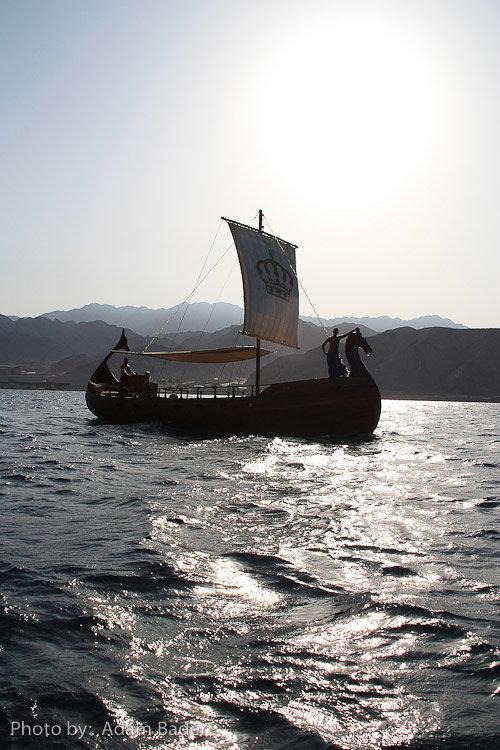
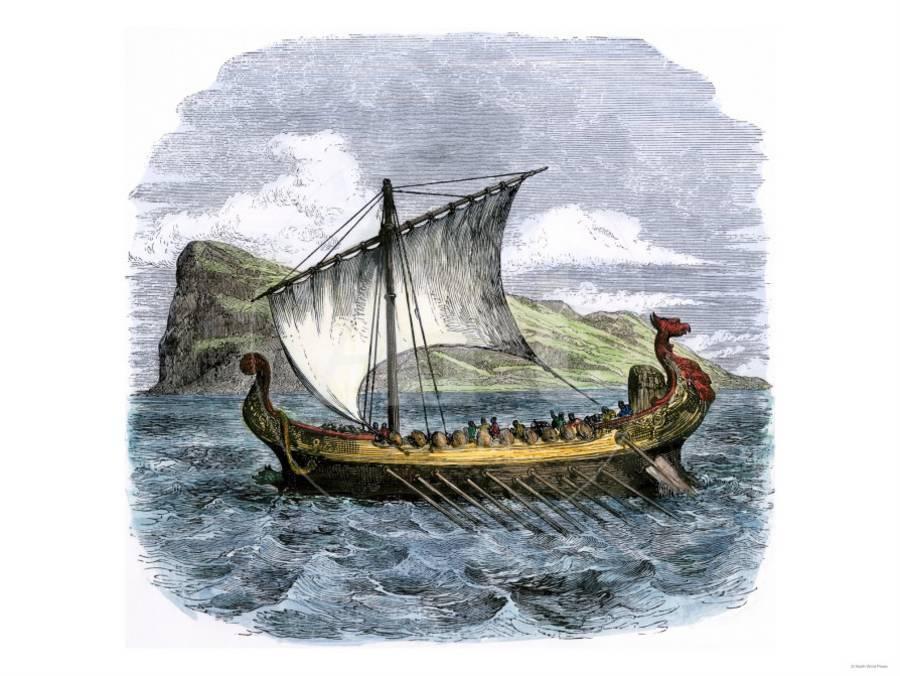
I think these look very appropriate for a sort of inspiration for the Conan ships, though I also think of them as slightly more “shippy” in my mind, if that makes any sense.
Another image:
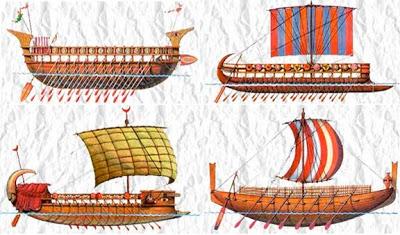
Helpful?
"I saw this in a cartoon once, but I'm pretty sure I can do it..."
22/11/2019 at 14:41 #126948Tony Hughes
ParticipantMost early ships used both oar & sail (some used paddles rather than oars) but I’m not sure what you mean by pre-COG so can’t be much more specific than that. Part of the problem is that searches for ships of the pre-classical era (Trojan Wars, Mycenaean etc) often show galleys of the classical era because many people think they are the same.
Trading vessels were often multifunctional, used as warships or raiders/pirates as the need arose (or opportunity presented itself). Bulk traders would be broader in beam and would operate under sail whenever possible as their smaller crew made rowing hard work and slow. Pre-classical smaller ships might be 20-30 oars and crews of no more than 30-50 all told, larger ones not all that much larger with crews 60-100 and 40-50 oars.
I’ll see if I can find reasonable images on the ‘net but I tend to use books more than the net for that area of interest. I’m a bit snowed under at the moment but I’ll see if I can scan some stuff and e-mail it to you sometime over the weekend.
Tony of TTT
22/11/2019 at 16:16 #126953 Mike HeaddenParticipant
Mike HeaddenParticipantI would think that the Sea Peoples ships from the freize at Medu Habinet in Egypt might do for a start. This is a fair approximation.

Magister Militum (https://www.magistermilitum.com/) already do a 15mm Mycenaean ship

A 1/50 scale Egyptian ship of similar period

Pinterest is a mine of visual (mis)information. Assuming you’re not too fussed about historical accuracy it would be a good place to rummage for inspiration.
There are 100 types of people in the world, those who understand binary and those who can work from incomplete data
22/11/2019 at 16:24 #126954Tony Hughes
ParticipantThe top image is reasonable, the MM ship is just silly – a ram fitted there would either break off on impact or break the prow timbers. It isn’t known for sure that these Egyptian ships were seagoing.
Bronze rams are definitely no earlier than the classical period and even wooden rams are considered unlikely as early as the Mycenaean age. A ‘pointed’ hull is considered a possibility but its purpose was more likely to be strengthening the bow or for better rowing qualities. Advances in ship construction appear to have taken place early in the classical era that make the ram feasible and lead to the development of progressively larger ships.
22/11/2019 at 16:27 #126955 MikeKeymaster
MikeKeymasterthe MM ship is just silly
Is it that bad?
They say it was based on an illustration on some ancient pottery?22/11/2019 at 17:00 #126957Tony Hughes
ParticipantIf that is so, and I’m not disputing that it could well be, it has been misinterpreted. To be honest, there have been some pretty vicious rows in academia over the ages about how to interpret images of ships. The ‘ram’ may be an extension of the keel timber rather than a separate item – but even that would make for big problems in shaping the other timbers around it to keep water out.
There is no doubt that some images on pre-classical pottery show something like the later rams but, from what has been so far found from the very limited shipwrecks of the Trojan war era, the hulls would not have been strong enough to cope with the stress of ramming. I’d have to admit that there are a lot of theories about the early ships that are yet to be proved or disproved – evidence is short so it wouldn’t be all that unreasonable to accept some of them if that is what you fancy.
22/11/2019 at 18:03 #126961 Mike HeaddenParticipant
Mike HeaddenParticipantOn the MM ship, although sold as a Mycenaean ship I believe it is based on Minoan frescoes.
I’m pretty sure it’s not a ram … since it seems to be attached to the back of the ship in the frescoes!! It only appears in images of large ships (as far as I know) and the two interpretations I like best are that it would serve to turn the ship into the wind, and keep it there, in bad conditions or that it was a device to assist the crew in hauling the ship ashore. That said, if someone asserted that it was a bronze age outboard motor I’d be hard put to prove otherwise 🙂
However, since we’re talking about ships for Conan inspired games, who knows what the technology of Hyborian, Stygian or Cimmerian ships were.
Does this mean Simurgh may eventually sport docks and wharves?
There are 100 types of people in the world, those who understand binary and those who can work from incomplete data
22/11/2019 at 18:07 #126962 Mike HeaddenParticipant
Mike HeaddenParticipantComputer image of the Minoan ship
There are 100 types of people in the world, those who understand binary and those who can work from incomplete data
22/11/2019 at 18:36 #126964Tony Hughes
ParticipantMike – No, it is at the bow of the ship in the model as it is crewed by oarsmen who face the stern.
In the computer image (of what looks to be an interpretation of the same idea) propulsion is by paddles – and very inefficient ones at that.
My only thought is that it is a misinterpreted boarding ladder – which is sometimes shown on early vase paintings in roughly that position.
Any link to the image they are taken from ? I’d be interested in seeing the original.
22/11/2019 at 18:40 #126965 zippyfusenetParticipant
zippyfusenetParticipantNot warships, but typical merchant vessels.
Everyone seems to be missing that point, including yourself.
A galley is a warship. It’s fast, good for running down prey if you’re a pirate. It needs many-many crew to work the oars, and they also can board and fight once you grapple a foe. It has not much cargo capacity, and not much endurance. You beach it most nights to cook and roister and camp ashore.
For a merchant vessel you want minimal crew, because feeding and paying crewmen cuts into profits. So, just a few oars for when you’re becalmed, a big sail with simple rigging that you only need a few men to work, and a round, beamy hull that can stow plenty of cargo. No ram, what would a merchant skipper do with one of those? Something like this reconstruction of the Ulunburun ship, an actual wreck from c. 1300 BC:
https://en.wikipedia.org/wiki/Uluburun_shipwreck
Conan and Belit did their pirating from a low, fast, black galley, but the vessels they caught were probably more like the Ulunburun ship.
You'll shoot your eye out, kid!
22/11/2019 at 18:52 #126966 Angel BarracksModerator
Angel BarracksModeratorDoes this mean Simurgh may eventually sport docks and wharves?
Simurgh itself is landlocked.
22/11/2019 at 19:17 #126971Tony Hughes
ParticipantIn the safe waters off the Med coast of modern Turkey a slow bulk trader such as you show would be a common trade vessel.
In the Black sea or even the Aegean saving money may not have saved your ship or its cargo from the galleys of the Myceneans or other ‘Sea Peoples’.
As I said in my earlier post, many rowed craft were multipurpose and long distance trade in valuable commodities (usually in relatively small quantities) would be more likely to be carried in a galley, using sail when it could and oars when it needed to.
Compare the armed East Indiamen of later times with the deep hulled merchant bulk carriers with a popgun or two on deck. You’d happily take the former into pirate infested waters but not the latter. It is the same idea, just a lot earlier in time.
Can’t comment on what may or may not have been done on a fantasy world, outside my scope I’m afraid.
22/11/2019 at 19:25 #126974 MikeKeymaster22/11/2019 at 19:26 #126975
MikeKeymaster22/11/2019 at 19:26 #126975 Mike HeaddenParticipant
Mike HeaddenParticipantDoes this mean Simurgh may eventually sport docks and wharves?
Simurgh itself is landlocked.
There is always the possibility of a river 🙂
After all most Sumerian cities were well inland but river traffic was extensive 🙂
Those ships look perfect Mike.
There are 100 types of people in the world, those who understand binary and those who can work from incomplete data
22/11/2019 at 19:32 #126981 Mike HeaddenParticipant
Mike HeaddenParticipantA detour back to Minoan “rams”

There are 100 types of people in the world, those who understand binary and those who can work from incomplete data
22/11/2019 at 19:37 #126982 Geof DowntonParticipant
Geof DowntonParticipantI have a 1/100 scale plan for a small Phoenician merchant ship, that I may one day get around to building for my Biblical types. I’ll email it to you. Essex have suitable crews, and also some probably-too-small boats.
One who puts on his armour should not boast like one who takes it off.
Ahab, King of Israel; 1 Kings 20:1122/11/2019 at 19:37 #126983 Mike HeaddenParticipant
Mike HeaddenParticipantFinally, a rather nifty modern reconstruction

There are 100 types of people in the world, those who understand binary and those who can work from incomplete data
22/11/2019 at 19:38 #12698522/11/2019 at 19:44 #126987 Mike HeaddenParticipant
Mike HeaddenParticipantThose a small merchant ships from the Early Roman Empire and if that’s the vibe you are looking for, more power to your elbow!
If you want a real challenge try modelling the Isis 😀
“The Roman ship Isis was a very large ship that operated on the Mediterranean during the Roman Empire around 150 AD, carrying grain from Egypt to Italy. The Isis was apparently 55 meters (180 feet) long and had a beam of 13.7 meters (45 feet). Its cargo hold was 13.4 meters (44 feet) deep. It displaced 1200 short tons or 1,071 long tonnes.” – Wikipedia
There are 100 types of people in the world, those who understand binary and those who can work from incomplete data
22/11/2019 at 19:52 #126988 Mike HeaddenParticipant
Mike HeaddenParticipantMy Mesopotamian Early Bronze Age and Roman fleets

There are 100 types of people in the world, those who understand binary and those who can work from incomplete data
22/11/2019 at 20:01 #126990Tony Hughes
ParticipantOK Mike, thanks for that, always better to be talking about the original and not an interpretation.
It looks like the builders of the MM model got either the bow & stern mixed up or someone put the oarsmen in the wrong way round.
If those are oarsmen on the original then they look very strange to me, no part of a normal rowing stroke has the arms & oars in that relative position but it doesn’t look quite right for paddlers either. The paddlers are the best interpretation because they can’t possibly be oarsmen unless you just assume the artist got it completely wrong.
Looking at the lower ship, the stern ‘thing’ seems to be a solid piece pivoted near the steering oar and with two rope ladders or similar holding it up. My best guess is that it is a loading ramp that can be let down to a beach for easy access to the deck.
22/11/2019 at 20:09 #126991Tony Hughes
ParticipantMike – yes, I’d be happy that those were reasonably representative of what I have read was possible. I might dispute a few details but mostly they tally with what I have read for merchant types right into the classical era. I think the top one might be a large vessel by contemporary standards and have doubts about decked over holds so early but OK.
In the images at the link the bottom one is a Roman grain ship, much too sophisticated for 1500-1200 BC.
The top one may have the right hull shape but the rigging is too complex, the main mast is too tall and the bowsprit is not evident that early – and ditch the cabin and probably the overall deck … but the hull look OK !!
22/11/2019 at 20:37 #126993 zippyfusenetParticipant
zippyfusenetParticipantBut they would be without oars?
I’d expect a couple pairs of sweeps to maneuver the vessel through tight places, but oars require oarsmen and a canny merchant captain would keep his crew small.
Of course if trade was to be pressed through hostile waters, that would require a fighting ship and crew, or a convoy with escorts. Bonhomme Richard was an East Indiaman. The King of France subsidized her construction as an auxiliary warship, and John Paul Jones took Serapis with her off Flamborough Head.
You'll shoot your eye out, kid!
22/11/2019 at 20:50 #126994Tony Hughes
ParticipantI see no reason why a merchant such as those illustrated by Mike above couldn’t carry a few oars but I’m not so sure that ancient economics worked the same as modern shipping trade. Do we know enough about how trade worked in a moneyless economy ? We have a pretty good idea of some aspects for the larger civilisations but not down to the details. Was there even a wage economy ? Were trading ships joint enterprises sailed by the ‘owners’ ?
We don’t really know for sure and simply assuming that economics worked the same then is making an unsupportable assumption – with all the potential misinterpretation that brings with it.
22/11/2019 at 21:29 #126995 PatriceParticipant
PatriceParticipantFirst question: what is the historical (or, fantasy/historical) context? (I’ve heard Conan was mentioned).
You wouldn’t see the same ships in a tropical, or mediterranean (?) context, or in cold seas…

http://www.argad-bzh.fr/argad/en.html
https://www.anargader.net/23/11/2019 at 15:23 #127026Deleted User
MemberThe first image in my head was a ship similar to this but without the roman dudes and smaller. Also I was thinking they’ll be semi below deck. I think having slaves as oarmen fits and they could load and unload cargo at smaller ports.
Something similar to this with oars poking form those darker patches on the sides.
https://3.bp.blogspot.com/-9XS3ztSgVeM/WL56NMaKVRI/AAAAAAAAeKw/8NuSSBZaiE0TFXLf1PTyRT2BwJyYiXjAwCLcB/w1200-h630-p-k-no-nu/egypt-boat.jpgThere might be a large lake near Sigmurgh.
23/11/2019 at 17:37 #127033 Mike HeaddenParticipant
Mike HeaddenParticipant“Ben-Hur” notwithstanding, slave oarsmen are very rare in antiquity. I can only think of a couple of instances, both during the Punic Wars.
Slaves pressed as oarsmen were normally freed beforehand, though the Romans at least once offered freedom afterwards to those who behaved well.
In boarding actions free oarsmen are additional troops, slaves need free crew diverted to guard them.
There are 100 types of people in the world, those who understand binary and those who can work from incomplete data
25/11/2019 at 16:08 #127111 Darkest Star GamesParticipant
Darkest Star GamesParticipantLooking at the lower ship, the stern ‘thing’ seems to be a solid piece pivoted near the steering oar and with two rope ladders or similar holding it up. My best guess is that it is a loading ramp that can be let down to a beach for easy access to the deck.
Many moons ago I was once assured by a professor at UCSD that the “widget” was a sort of kickstand for when the boat was beached. He said it’d keep the boat level, rather than having to be laid on one side or the other, as well as used as a primitive bowplane, to keep the bow from riding too high when going over a wave, which could cause the keel to break in rough conditions.
I have not idea if any of that is true or even makes sense, not my specialty, and probably not a help.
I think you have a lot of options, and I don’t see why you can’t have a variety of ships. I’d stay away from those that are of “ancient” design as that seems a bit too far back for what Howard would have had in mind.
"I saw this in a cartoon once, but I'm pretty sure I can do it..."
25/11/2019 at 23:37 #127124 Mike HeaddenParticipant
Mike HeaddenParticipantMany moons ago I was once assured by a professor at UCSD that the “widget” was a sort of kickstand for when the boat was beached. He said it’d keep the boat level, rather than having to be laid on one side or the other, as well as used as a primitive bowplane, to keep the bow from riding too high when going over a wave, which could cause the keel to break in rough conditions.
I have not idea if any of that is true or even makes sense, not my specialty, and probably not a help.
I think you have a lot of options, and I don’t see why you can’t have a variety of ships. I’d stay away from those that are of “ancient” design as that seems a bit too far back for what Howard would have had in mind.
I’ll happily add that to my “It’s not a ram but it might be a ……” list!
As to ship design, I’m not sure coastal trading ships changed all that much from 3000BC to 1000AD 🙂
There are 100 types of people in the world, those who understand binary and those who can work from incomplete data
26/11/2019 at 00:14 #127126 Autodidact-O-SaurusParticipant
Autodidact-O-SaurusParticipantA kickstand? Color me dubious.
Self taught, persistently behind the times, never up to date. AKA ~ jeff
More verbosity: http://petiteguerre.blogspot.com/ -
AuthorPosts
- You must be logged in to reply to this topic.



